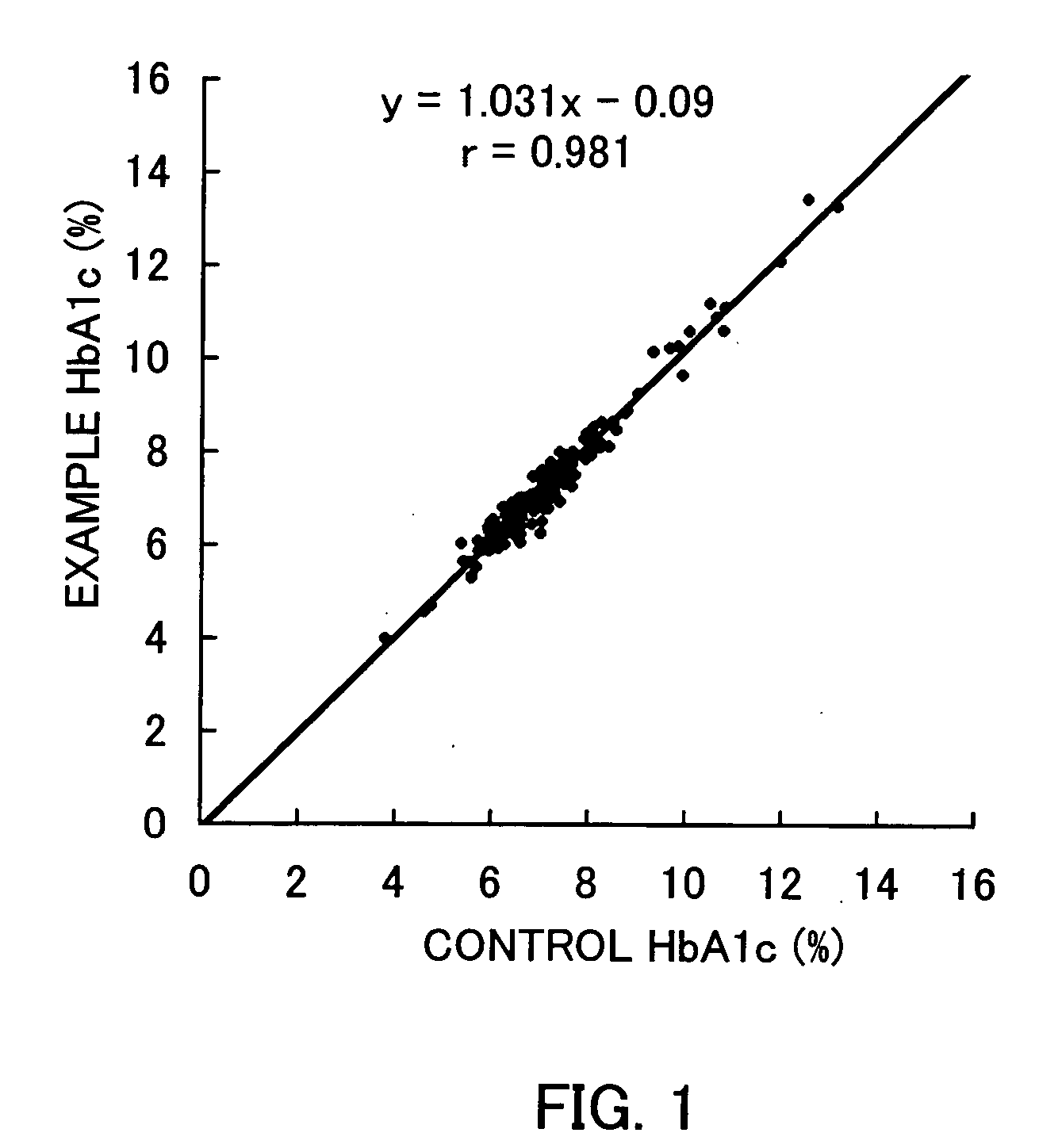Method of quantifying glycosylated protein using redox reaction and quantification kit
a glycated protein and redox reaction technology, applied in the field of glycated protein measurement using redox reaction and measuring kit, can solve the problems of insufficient measurement sensitivity of conventional methods, and the measured value of glycated hb may jump temporarily, so as to reduce power and improve measurement accuracy.
- Summary
- Abstract
- Description
- Claims
- Application Information
AI Technical Summary
Benefits of technology
Problems solved by technology
Method used
Image
Examples
embodiment a-1
(Embodiment A-1)
The present embodiment is an example where a FAOD-α is used to degrade a glycated amino acid while a FAOD-αS is used to measure glycated Hb and a redox reaction is caused in the presence of a tetrazolium compound and sodium azide.
First, whole blood itself is hemolyzed, or a blood cell fraction is separated from whole blood in the usual way such as centrifugation and then hemolyzed, so as to prepare a hemolyzed sample. The method of causing the hemolysis is not particularly limited, and can be, for example, a method using a surfactant, a method using ultrasonic waves, and a method utilizing a difference in osmotic pressure. Among these, the method using a surfactant is preferable because of its simplicity in operation, etc.
As the surfactant, for example, non-ionic surfactants such as polyoxyethylene-p-t-octylphenyl ether (e.g. Triton series surfactants), polyoxyethylene sorbitan alkyl ester (e.g. Tween series surfactants), polyoxyethylene alkyl ether (e.g. Brij s...
embodiment a-2
(Embodiment A-2)
The present embodiment is an example where the same FAOD is used to degrade a glycated amino acid and to measure glycated Hb. The FAOD used is not particularly limited, and for example, any of a FAOD-α, a FAOD-S, and a FAOD-αS may be used. In the present embodiment, measurement is carried out in the same manner as in Embodiment A-1, unless otherwise stated.
A hemolyzed sample is pretreated by adding a tetrazolium compound and sodium azide thereto, and a degradation FAOD is added to this pretreated hemolyzed sample.
Specifically, the conditions of the degradation FAOD treatment are, for example, as follows: the concentration of the degradation FAOD in the reaction solution in the range from 10 to 5000 U / l, the concentration of the blood cells in the reaction solution in the range from 0.5 to 20 vol %, the reaction temperature in the range from 20° C. to 50° C., the reaction period in the range from 1 minute to 1 hour, and the pH in the range from 6 to 9. This treat...
embodiment a-3
(Embodiment A-3)
The present embodiment is an example where the same FAOD is used to degrade a glycated amino acid and to measure glycated Hb. In the present embodiment, measurement is carried out in the same manner as in Embodiment A-1, unless otherwise stated.
The present embodiment differs from Embodiment A-2 in that it is not always necessary to inactivate a degradation FAOD with a protease. Because of the substrate specificity of enzymes, inactivating a FAOD with a protease can be difficult depending on the combination of the FAOD and protease. A method for measurement according to the present embodiment is effective in such a case. If a degradation FAOD added first reacts with a glycated Hb degradation product formed by the treatment with a protease, the accuracy of the measurement cannot be improved. Accordingly, it is important to adjust the ratio of a degradation FAOD to a measurement FAOD added to a sample as described later.
A hemolyzed sample is pretreated by adding a ...
PUM
| Property | Measurement | Unit |
|---|---|---|
| temperature | aaaaa | aaaaa |
| color | aaaaa | aaaaa |
| concentration | aaaaa | aaaaa |
Abstract
Description
Claims
Application Information
 Login to View More
Login to View More - R&D
- Intellectual Property
- Life Sciences
- Materials
- Tech Scout
- Unparalleled Data Quality
- Higher Quality Content
- 60% Fewer Hallucinations
Browse by: Latest US Patents, China's latest patents, Technical Efficacy Thesaurus, Application Domain, Technology Topic, Popular Technical Reports.
© 2025 PatSnap. All rights reserved.Legal|Privacy policy|Modern Slavery Act Transparency Statement|Sitemap|About US| Contact US: help@patsnap.com

